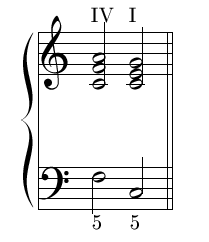Harmony/Cadences & Phrases
A cadence is a chord progression to end a phrase. A cadence uses strong harmonic movements to create a sense of resolution or closure.
Cadences
[edit | edit source]Perfect
[edit | edit source]
V to I
Perfect cadences are those that go from the dominant chord and resolve on the tonic chord. They are typically the cadence of choice for the end of a movement or piece
Imperfect
[edit | edit source]
X to V (where X is typically ii or IV)
Imperfect cadences go from a chord to the dominant chord. They are often used in the middle of a movement, providing some resolution: despite this, they do not provide such a strong closure as a perfect or plagal cadence.
Phrygian
[edit | edit source]IVb to V♮ [1]
Phrygian cadences are a special kind of imperfect cadence. Heard in a minor key, they move from an inversion of the subdominant chord to the dominant chord (harmonically: IVb to V♮) This type of cadence is often considered very lamenting, heard in sadder music. It was most popular in the Baroque Era.
Plagal
[edit | edit source]
IV to I
Plagal cadences go from the subdominant chord to resolve on the tonic chord. They are typically reserved for the end of a piece. Plagal cadences also usually have both chords in root position.
The plagal cadence is often called the 'amen' cadence because of its association with liturgical music, especially from the Renaissance and Baroque eras.
Interrupted
[edit | edit source]
X to vi (where X is typically V or iii)
Interrupted cadences go from a chord (most often chord V) to the submediant chord. This sounds unresolved, or interrupted.
Phrases
[edit | edit source]Phrasing primarily originates from the direct influence of vocal music. A singer can only keep singing for a certain length of time before running out of breath, so in nearly all music, phrases are a comfortable length to sing in one breath. On top of this, if multiple phrases are used, they are often the same length, as the repetition of the same pulse makes it easier to learn a piece of music.
References
[edit | edit source]- ↑ "Phrygian cadence - Wiktionary". en.wiktionary.org. Retrieved 2019-12-31.
